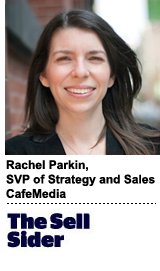
“The Sell Sider” is a column written by the sell side of the digital media community.
Today’s column is written by Rachel Parkin, senior vice president of strategy and sales at CafeMedia.
There is a question that has increasingly surfaced in conversations with agencies and demand-side platforms recently, which seems almost retro at first: “What does your ad stack look like?”
Header bidding was the great equalizer to the publisher waterfall of yesteryear. To a large extent, header bidding flattened the waterfall and made questions about access to inventory a moot point as all independent supply exchanges theoretically have the same opportunity to win.
So, what’s behind the sudden interest in the publisher waterfall and ad stack again?
The answer is intriguing. It’s less about the practical structure and more about driving a deeper relationship and conversation between buyers and publishers.
A typical publisher waterfall today
The publisher waterfall today is simpler than before.
Most publishers have four types of inventory deals: (1) sponsorships, (2) direct-sold or reserved programmatic buys, (3) private marketplaces and (4) open auctions.
Google Ad Manager’s out-of-the-box priority delivers sponsorships ahead of standard line items and then groups all price priority bidders together, where the highest price wins. (The exception to this being that dynamic allocation and optimized competition allows AdX to compete with standard line items if they are pacing to deliver in full.)
The ad stack has become much more complex though, and the levers and nuances that determine inventory access have shifted over time. There is a new set of questions the buy side can probe to understand how the ad server perceives a bid and the effective priority for any given publisher.
The first consideration is how much inventory is sold through reserved and unreserved channels. Publishers occupy both ends of those spectrums and everything in between. For some publishers, reserved buying still comprises a majority of impressions sold, and win rates and scalability are heavily influenced by whether programmatic opportunities are jury-rigged to compete with standard line items or clear after. Other programmatic-first publishers have very little reserved inventory sales and nearly all inventory is available for programmatic buyers. Priority vs. standard lines has no meaning for publishers with sizable access to inventory regardless.
A second element to consider is how supply-side partners are trafficked. While exchange partners likely live within the same level of the waterfall, the way they are trafficked may impact how the ad server processes their bids. Are all supply partners grouped into one order bucket? Are partners broken out into separate orders? And, if so, are the same price increments used?
As an extra layer, how are private marketplaces (PMPs) handled? Breaking out each individual PMP or groups of PMPs separately can provide more flexibility to control priority. There are many different best practices for ad-stack setup, and knowledge of what a publisher does will provide insight into setting the right expectations for ad delivery.
The last factor is the array of configuration possibilities that happen within each supply-side platform (SSP). Before bids reach the ad server, many SSPs have features to set priorities for specific buyers or PMP deals and enable or turn off open-market competition with PMPs. And, of course, publishers also specify price floors, inventory types and blocks and any other number of global settings that may vary across different SSP partners.
What buyers and sellers gain by sharing
Conversations about the waterfall are just the tipping point of a more open dialogue between buyers and sellers.
With all the hops, skips and jumps in the industry, diving into publishers’ ad stacks is a start toward bridging the gap between buyers and sellers. Knowing how a publisher organizes its supply partners will give buyers a better understanding of how they fit in and set expectations for scale. A buyer may not be able to change or influence a publisher’s structure, but it could indicate if a more customized approach would be beneficial. As the buy side looks to remove unnecessary supply paths, digging in one by one with key publishers is a great way to see where creative strategies can deliver better performance.
The potential for sharing rises above the ad stack, too. Publishers have access to detailed auction-level data that buyers don’t normally see. Surfacing insights from that data can reveal the benefits of different auction dynamics (such as first-price vs. second-price), frequency of bids making it to the ad server and effective win rates at different bid prices.
These analyses enable buyers and sellers to partner together to make informed decisions on deal structures and pricing that help advertisers win more of the impressions they want. When advertisers also bring data to the table, there is a huge opportunity to collaborate. Connecting publishers’ content with bid patterns and investment returns creates a feedback loop that drives innovation.
I often get the sense that the buyers asking publishers questions about their ad stack feel like they’re asking for a trade secret. The secret is publishers are happy to invite buyers to the other side of the waterfall and beyond.
Follow CafeMedia (@CafeMedia_) and AdExchanger (@adexchanger) on Twitter.
This post was syndicated from Ad Exchanger.


More Stories
Kiwi filmmaker spotlights media struggles at top global awards
T-Mobile Has Appointed Kristin Harrer As Senior Vice President and Chief Brand Officer
Taste paradise with Whittaker’s new Mango & Coconut block